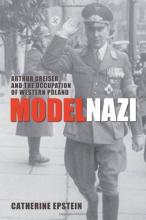A Message from the Author - Associate Professor of History Catherine Epstein
 |
In 2003, I published a book on longtime communists in East Germany, The Last Revolutionaries. I then faced a decision: did I want to spend the next thirty years researching in the East German archives? Did I want to read more dull communist documents, written in the hackneyed prose of communist functionaries? The answer was a resounding no.
Instead, I read up on a new interest: “ethnic cleansing.” I was struck by the ways in which Germans and Poles had engaged in rival ethnic cleansing measures between 1880 and 1950. I chose a region–the Posen/Poznań area (now in western Poland)–and planned to study the escalation of ethnic cleansing there. In preparation for this work, I took a first-year Polish language class at the University of Massachusetts.
But in studying the region’s history, I repeatedly came across the name Arthur Greiser—the man who was the party leader (Gauleiter) and governor (Reichsstatthalter) during the Nazi occupation of the region, then known as the Warthegau. I soon realized that Greiser’s life spanned all of the periods of German/Polish ethnic cleansing. In archives in Germany and Poland, I also found many personal documents that Greiser had left behind. These included letters home to his parents during World War I and letters to his mistress (later wife) in the early 1930s. Despite the wealth of personal and other documents on Greiser, there was only a brief biography of the man—in Polish. I now had my new research topic!
Working on Greiser involved a steep and thrilling learning curve; I was not trained as a historian of Nazi Germany or the Holocaust. At the same time, writing something original about the Nazi regime or the Holocaust is no simple matter. But as I worked more on Greiser, I realized that he did not fit the stereotypical image of an anti-Semitic, second-tier Nazi who merely carried out Hitler’s orders. Instead, I was struck by how much Greiser was able to determine policies in the Warthegau. Morever, Greiser’s goals came as something of a surprise: his main aim was to make the Warthegau “German.” To this end, he imported hundreds of thousands of ethnic Germans, tried to transform the built and natural environment, mercilessly persecuted Poles, and exploited and murdered the Warthegau’s large Jewish population. As readers will learn, Greiser was eager to create a “model” German Gau; he spared no miserable effort to achieve his aims.
QUESTIONS TO KEEP IN MIND WHEN READING
- If World War I and the Depression had never happened, Greiser would likely never have become a Nazi. How and why do men (and they are mostly men) become perpetrators? What motivates them to become perpetrators?
- In Model Nazi, I make an argument that weak perpetrators–individuals who feel that they have something to prove–are perhaps the most dangerous perpetrators. What were the factors in Greiser’s life that made him feel that he had to prove himself as a Nazi?
- Why is the book titled Model Nazi?
- In Model Nazi, I argue that the Holocaust was part of a much broader Nazi Germanization strategy for Eastern Europe. What were the other elements of Germanization strategy? How did the Final Solution fit into more general Nazi racial policies?
- How much power or influence did second-tier Nazis have? How and why was Greiser able to implement policies of his choice in the Warthegau?